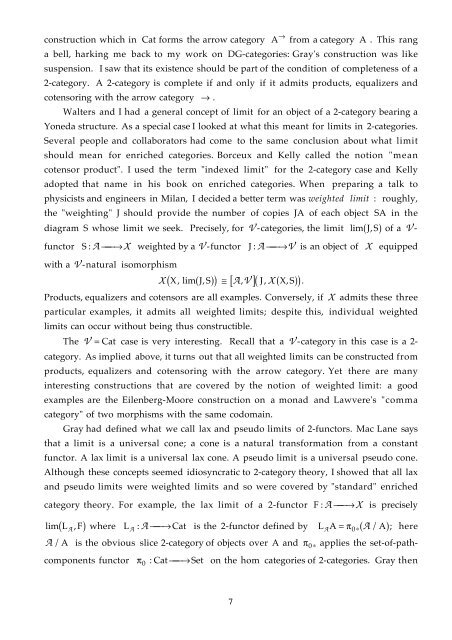An Australian conspectus of higher categories - Macquarie University
An Australian conspectus of higher categories - Macquarie University
An Australian conspectus of higher categories - Macquarie University
Create successful ePaper yourself
Turn your PDF publications into a flip-book with our unique Google optimized e-Paper software.
construction which in Cat forms the arrow category A Æ from a category A . This rang<br />
a bell, harking me back to my work on DG-<strong>categories</strong>: Gray's construction was like<br />
suspension. I saw that its existence should be part <strong>of</strong> the condition <strong>of</strong> completeness <strong>of</strong> a<br />
2-category. A 2-category is complete if and only if it admits products, equalizers and<br />
cotensoring with the arrow category Æ .<br />
Walters and I had a general concept <strong>of</strong> limit for an object <strong>of</strong> a 2-category bearing a<br />
Yoneda structure. As a special case I looked at what this meant for limits in 2-<strong>categories</strong>.<br />
Several people and collaborators had come to the same conclusion about what limit<br />
should mean for enriched <strong>categories</strong>. Borceux and Kelly called the notion "mean<br />
cotensor product". I used the term "indexed limit" for the 2-category case and Kelly<br />
adopted that name in his book on enriched <strong>categories</strong>. When preparing a talk to<br />
physicists and engineers in Milan, I decided a better term was weighted limit : roughly,<br />
the "weighting" J should provide the number <strong>of</strong> copies JA <strong>of</strong> each object SA in the<br />
diagram S whose limit we seek. Precisely, for V -<strong>categories</strong>, the limit lim ( JS , ) <strong>of</strong> a V -<br />
functor S:A æ æÆX weighted by a V -functor J:A æ æÆV is an object <strong>of</strong> X equipped<br />
with a V -natural isomorphism<br />
X X, lim ( J, S) A, V J, X X, S<br />
( ) @ [ ] ( ( ) ).<br />
Products, equalizers and cotensors are all examples. Conversely, if X admits these three<br />
particular examples, it admits all weighted limits; despite this, individual weighted<br />
limits can occur without being thus constructible.<br />
The V = Cat case is very interesting. Recall that a V -category in this case is a 2category.<br />
As implied above, it turns out that all weighted limits can be constructed from<br />
products, equalizers and cotensoring with the arrow category. Yet there are many<br />
interesting constructions that are covered by the notion <strong>of</strong> weighted limit: a good<br />
examples are the Eilenberg-Moore construction on a monad and Lawvere's "comma<br />
category" <strong>of</strong> two morphisms with the same codomain.<br />
Gray had defined what we call lax and pseudo limits <strong>of</strong> 2-functors. Mac Lane says<br />
that a limit is a universal cone; a cone is a natural transformation from a constant<br />
functor. A lax limit is a universal lax cone. A pseudo limit is a universal pseudo cone.<br />
Although these concepts seemed idiosyncratic to 2-category theory, I showed that all lax<br />
and pseudo limits were weighted limits and so were covered by "standard" enriched<br />
category theory. For example, the lax limit <strong>of</strong> a 2-functor<br />
( ) where<br />
lim L , F<br />
A<br />
L : æ æÆCat is the 2-functor defined by<br />
A A<br />
F:A æ æÆX is precisely<br />
L A p0 A / A ; here<br />
A<br />
= ( )<br />
A /A is the obvious slice 2-category <strong>of</strong> objects over A and p 0 * applies the set-<strong>of</strong>-path-<br />
components functor p0 : Cat æ æÆSet on the hom <strong>categories</strong> <strong>of</strong> 2-<strong>categories</strong>. Gray then<br />
7<br />
*
















